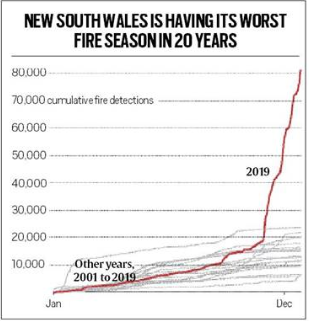Australian Bushfire | 17 Jan 2020
Why in News
Australia is witnessing its most devastating bushfire season in at least 20 years.
Concept of Bushfires
- Season: Forest fires, or bushfires, routinely occur across the world in hot and dry seasons.
- Reason: Dry leaves, grass, shrubs, deadwood etc are easily combustible. Ignition happens naturally, from lightning strikes for example, or accidentally, from sources such as cigarette stubs.
- Spread and End: Suitable speed and direction of wind helps spread a forest fire faster. It usually comes to an end due to rain or because there is no further contiguous vegetation to spread to.
- Man -made fires: Sometimes, fires are ignited on purpose, for example, in 2019, the fires in the Amazon forests in Brazil had become controversial because they were largely seen to have been a result of deliberate burning by farmers and large agro-industry players keen on getting more land.
- Indian Context: During the summer months, fires are common in the forests of India as well.
Common in Australia
- Driest Inhabited Continent
- Australia, where the summer starts around October, is known to be the most fire-prone of all continents. This is mainly because Australia is also the driest inhabited continent.
- Almost 70% of its area comprises arid or semi-arid land, with average annual rainfall less than 350 mm.
- Bushfires and forest cover
- Australia has about 134 million hectares of forest land. Bushfires are pretty common every year in summer.
- Australian government data show that about 55 million hectares of forest land, i.e more than 40% of the entire forests, had been affected by at least one such fire in the period between 2011 and 2016.
Difference in 2020
- This Australian summer, the spread and intensity of forest fires are something never seen before. The fire has impacted more than 10.3 million hectares of forest land so far, an area the size of South Korea. People and millions of wild animals have died.
- Reasons
- Prolonged Drought
- The three years between 2017 and 2019 were the driest 36-month period ever in the New South Wales (a state of Australia).
- 2019 happened to be the warmest and driest year for the country since 1900.
- Daytime temperatures were, on average, 2°C higher than normal, while the average rainfall for the country was 40% below normal.
- Heat and dryness are the key preconditions for the ignition and spread of forest fires.
- Positive Indian Ocean Dipole (IOD)
- In 2019, the problem has been compounded by the presence of one of the strongest-ever positive Indian Ocean Dipole (IOD) events. Positive IOD events are often associated with a more severe fire season for South-east Australia.
- Rare stratospheric warming over Antarctica
- Temperatures were 30°C to 40°C higher than normal in the region 10 to 50 km from Earth’s surface — another extraordinary weather event that could have contributed to the unusual heat and dryness in Australia.
- Prolonged Drought
- Link with climate change
- Experts say climate change has worsened the scope and impact of natural disasters such as fires and floods. Weather conditions are growing more extreme, and for years, the fires have been starting earlier in the season and spreading with greater intensity.
Impact of IOD on India and Australia
- The IOD refers to the difference in sea-surface temperatures in the eastern and western Indian Ocean. This either aids or cuts off moisture supply to Australia, depending on whether the western Indian Ocean is cooler or the eastern.
- This year, the eastern Indian Ocean has been unusually cold, and that contributed to the rainfall deficiency over Australia.
- The 2019 June-September monsoon in India started its withdrawal on October 9, against the normal date of September 1, making it the most delayed in recorded history. It was also the strongest in recent years with a surplus of 10% in 2019 — both attributed in part due to the positive phase of the Indian Ocean Dipole (IOD).
- During a positive IOD phase, the west Indian Ocean warms up anomalously (creating lower pressure and wet climes) relative to the east (higher pressure and a dry phase, towards the Australian side).
- A positive IOD that has persisted longer than usual is thought to have contributed to a delay in transition of the monsoon trough from the Northern Hemisphere to the Southern Hemisphere and onset of the Australian monsoon.
